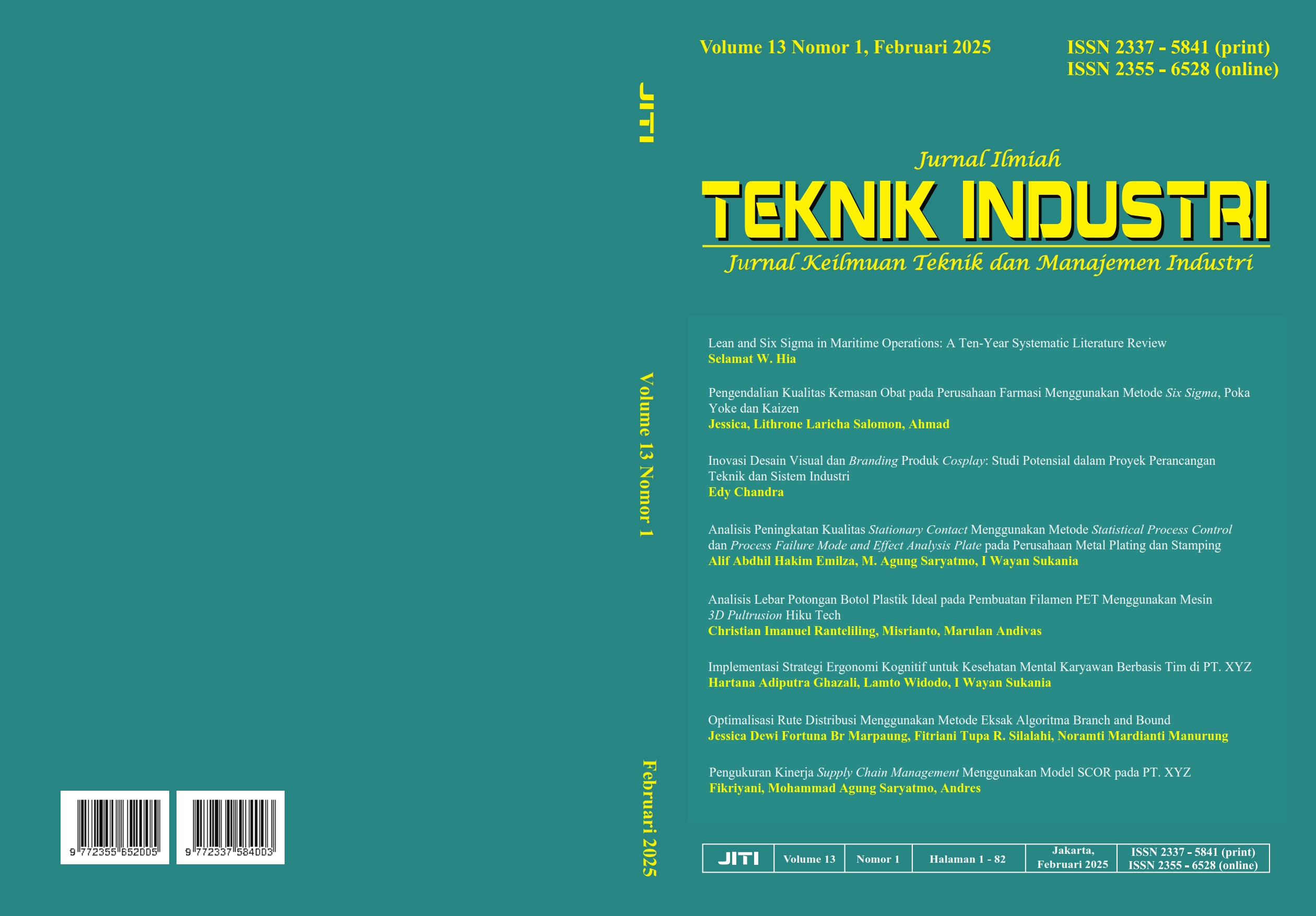IMPLEMENTASI STRATEGI ERGONOMI KOGNITIF UNTUK KESEHATAN MENTAL KARYAWAN BERBASIS TIM DI PT. XYZ
Main Article Content
Abstract
This study aims to identify employees’ mental workload and evaluate the effectiveness of cognitive ergonomics strategies within the team-based work system at PT. XYZ. Data collection involved the NASA-TLX method for measuring mental workload, the DASS-21 questionnaire to assess psychological conditions, and employee perceptions regarding the implementation of cognitive ergonomic strategies. Additionally, Pearson correlation analysis, Failure Mode and Effect Analysis (FMEA), and a Pareto diagram were used to support data interpretation. The results showed that most respondents experienced light to moderate mental workload, with generally positive perceptions toward the applied ergonomic strategies. Although statistical correlations among variables were not significant, data patterns and field findings suggest that cognitive ergonomics contribute to stress reduction and increased productivity. In conclusion, implementing appropriate and sustainable cognitive ergonomic strategies is essential to support mental health in a team-based work environment.
Article Details

This work is licensed under a Creative Commons Attribution-NonCommercial-ShareAlike 4.0 International License.

All publications by Jurnal Ilmiah Teknik Indsutri (Jurnal Keilmuan Teknik dan Manajemen Industri ) [p-ISSN: 2337-5841, e-ISSN: 2355-6528] is licensed under a Creative Commons Attribution-ShareAlike 4.0 International License.
References
[1] I.N. Sulaeman, P. Setiawan, W.J. Rumbia,Y. Lasmita, M. Tuljannah, D. Sartika, R.A. Sandi, A. Isnaeni, and S.K. Saptaputra, “Kesehatan Mental di Tempat Kerja,” Jurnal Ilmiah Mahasiswa Kesehatan Masyarakat, vol. 8, no. 4, pp. 1-18, 2023.
[2] H. Amelya, H. Pratiwi, Z. Rahmadania Alrefi and Akbari, “Peran Psikologi Industri dalam Mengurangi Stres Kerja dan Meningkatkan Kesejahteraan Karyawan,” Jurnal Inovaso Pendidikan Kreatif, vol. 5, no. 4, pp. 353-370, 2024.
[3] A. Hakiim, W. Suhendar, and D.A. Sari, “Analisis Beban Kerja Fisik dan Mental Menggunakan CVL dan NASA-TLX pada Divisi Produksi PT X,” Barometer, vol. 3, no. 2, pp. 142-146, 2018.
[4] A.M.A. Rahman, “Analisis Pengendalian Kualitas Produk Roti Tawar Mr. Bread dengan Metode FMEA (di Bagian Produksi CV. Essen),” Industrial Engineering Online Journal, vol. 3, no. 4, pp. 209-224, 2014.
[5] A.W. Putri, B. Wibhawa and A.S. Gutama, “Kesehatan Mental Masyarakat Indonesia (Pengetahuan, dan Keterbukaan Masyarakat Terhadap Gangguan Kesehatan Mental),” Prosiding Penelitian dan Pengabdian Kepada Masyarakat, vol. 2, no. 2, pp. 147-300, 2015.
[6] A. Sabrini, A. Jabbar, M. Rambe, and D. Wahyuni, “Pengukuran Beban Kerja Karyawan dengan Menggunakan Metode SWAT (Subjective Workload Assessment Technique) dan Work Sampling di PT. XYZ,” e-Jurnal Teknik Industri FT USU, vol. 8, no. 2, pp. 6-13, 2013.
[7] E.K. Sari, “Analisis Beban Kerja dengan Menggunakan Metode Nasional Aeronatics and Space Administration Task Load Index (NASA-TLX) dan Subjective Workload Assessment Techinque (SWAT) di Lantai Produksi PT. Harian Umum Haluan Riau,” Tugas Akhir, UIN SUSKA Riau, 2021.
[8] F. Yolanda, F. Egianto, F. Armita, L.A. Wahyuni, M.U. Sari M., R. Cahyani, S. Rahayu, and T. Saputri, “Studi Literatur: Korelasi Bivariat Menggunakan Uji Korelasi Koefisien Kontingensi, Jurnal Pendidikan Tambusai, vol. 8, no. 2, pp. 18300-18312, 2024.
[9] M.A. Hakim and N.V. Aristawati, “Mengukur Depresi, Kecemasan, dan Stres pada Kelompok Dewasa Awal di Indonesia: Uji Validitas dan Reliabilitas Konstruk DASS-21,” Jurnal Psikologi Ulayat: Indonesian Journal of Indigeneous Psychology, vol. 10, no. 2, pp. 232-250, 2023.



